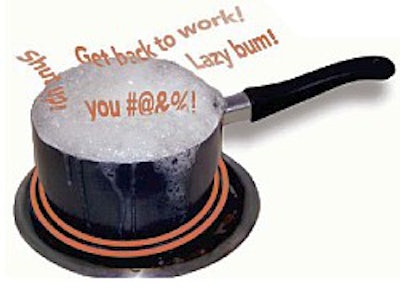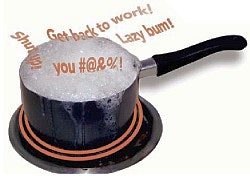

What would you do in this situation?
You made a scheduling mistake, and realize you have to move up the completion date for a big job. You tell your employees they have to stay late this week to get everything done. Joe, whose frequent negative remarks have always irritated you, suddenly explodes. With other employees right there, he angrily spouts: "If you knew what you were doing, we wouldn't all be stuck here."
You're thunderstruck. You feel anger welling up inside. You can either . . .
A. Scream at Joe to shut up and get back to work.
B. Take a deep breath, then discuss the matter of staying after hours with Joe and the rest of your staff, addressing their concerns.
C. Inform Joe that he is out of line with his comments and ask him to talk to you privately before he leaves the job that day.
Which of the proposed responses yields the best results?
Bosses get angry
If you've been managing for awhile, you have probably encountered similar situations. The "Joes" of the world can be a unique problem. Often, they perfect the practice of needling you without going so far to get fired. Their remarks can slowly generate anger inside you. Eventually you come to a boiling point.
What to do? If you're like most people, you feel the urge to yell back at Joe. Who wouldn't get some satisfaction from returning fire? Such retaliation, though, can damage your business and your reputation.
"When you get angry, the points you want to make are lost," says Lisa Costas, a psychologist with the Counseling Center for Human Development at the University of South Florida, Tampa. "You need to maintain a level of composure so your message is clear and is not buried in an emotional reaction." Expressing anger at a professional level, says Costas, means not being abusive, and not using power to get even or oppress. That means addressing the outburst in a private meeting during which you can discuss the issues calmly.
So how should you handle Joe? Avoid escalating the conflict by addressing his comment in front of fellow employees. The group setting has another drawback: You need to discover what is really troubling Joe, but he will be hesitant to communicate such information in front of his coworkers.
The best approach, says Costas, is to calm yourself (try counting to 10) and then pick a time to discuss the matter. Costas suggests a statement along these lines: "I'm sorry I made a mistake. We still have to stay late this week, and I will be here helping out. I would like to schedule a meeting with you this afternoon at 2 p.m. to discuss what happened."
What causes your anger?
Allow sufficient time to prepare for the meeting. You will need to collect your thoughts and develop a plan. "Start by clarifying your own feelings of anger," suggests John Mayer, a University of New Hampshire psychologist. "Enumerate the various things at its roots and figure out the best way of dealing with it based on where it's coming from."
Here are some possible sources of your rage:
• Humiliation from being put down in front of your employees.
• Frustration from not having instructions carried out.
• Shame from failing to have your team pull through.
Be wary of transferences from your personal life. For example, does your anger stem partly from Joe's looks or mannerisms that resemble those of your bratty 15-year-old son? "Don't get into a kick-the-dog mentality," says Francis J. Friedman, president of Time & Place Strategies, a New York City-based consulting firm. "You must leave family issues at home."
Be aware of other contributing factors. "Anger always has a component of fear, and it can be multi-dimensional,"says Friedman. "When we feel trapped, the only outlet is to be angry at the people who work for us." Do you fear the failure of missing business goals? Do you fear you won't reach your own life goals? Do you fear you will be laughed at by peers or family? Or do you fear all of these to some extent?
The next step is to consider what may be going through Joe's mind. "Try to understand the individual who has expressed anger," says Laura Boyd-Brown, president of Parker, Boyd-Brown and Associates, a consulting firm in Dartmouth, N.S. What components might be involved?
Possibilities include:
• Ongoing frustrations that have suddenly erupted because of one final issue.
• Difficulties in his home life.
• Poor ability to communicate what he needs to get the job done.
Write down your ideas. If conditions permit, sleep on the problem prior to your meeting with Joe. It's important to take time to think about the issue and what you want to say.
What to do when it happens
Your meeting with Joe should accomplish two goals. The first is to inform Joe that he must modify the way he expresses his displeasure. The second is to find out what is troubling Joe in order to reduce workplace friction down the road.
Start by communicating your anger about Joe's behavior, but do so in away that leads to productive interaction. A possible opener is: "I didn't appreciate the way you addressed me, especially in front of the other guys. In the future if you have a complaint, I expect that you will come to me personally, and we will discuss it."
Next, it's important to encourage Joe to open up with his feelings. "Your meeting with Joe is basically a negotiation," says Ian Jacobsen, president of Jacobsen Consulting Group in Sunnyvale, Calif. "One of the first rules of negotiation is that you can't operate effectively unless you understand the other person's position."
The best strategy is to listen until Joe has spilled his guts. Jacobsen advises a statement such as this: "Okay, Joe, expand on what you said. I want to know where you are coming from."
To help Joe talk, your demeanor should communicate genuine interest in his ideas rather than confrontation or accusation. "Monitor your tone of voice and body language," suggests Costas. "We don't have to like the people we work with, but we have to maintain professional relations so we can work together."
As Joe talks, jot down key words you want to remember. When Joe has finished talking, he should be ready to listen. At that point, Jacobsen suggests responding to Joe's main points. Avoid confronting Joe in an argumentative manner, or contradicting his statements. Your goal is to change Joe's behavior so he is a productive employee, not to change his mind or prove your worth. And Joe will be more likely to listen if he understands you are not trying to challenge his position.
Jacobsen suggests language such as this: "Joe, I understand these points you are making, and there is some validity to them. I take exception on these other points [ . . .] for these reasons [ . . . ]. I'm not trying to get you to change your mind, but I want you to understand where I am coming from."
Once you have laid out the scenario as to why the schedule had to change, you can encourage more interaction by asking: "Okay Joe, if you were in my shoes what would you do?"
Says Jacobsen: "Maybe Joe has some good ideas. Maybe he doesn't. But getting him to try to look at the problem from your perspective is important in terms of opening up his mind. At the same time, you are learning more about how to deal with him."
At the end of the discussion, restate and summarize Joe's key points to let him know that you really did listen and that you can empathize.
When handled properly, anger can improve workplace relationships. "Rather than feeling bad about your anger, recognize that it is a natural emotion, especially when you are challenged by a subordinate," says Jacobsen. "Realize that you have the ability to meet the challenge of anger in a constructive way. If you take time to plan your response, you are much more apt to look back later and feel good about how you handled the situation."
When Employees Don’t Perform
If you are feeling anger toward an employee who has been doing a bad job or who has failed to do what he’s supposed to, avoid the temptation to yell. Expressing anger by shouting or name-calling is counterproductive. “In the old days, intimidation was a fringe benefit of being a manager,” says Ronald T. Potter-Efron, a partner and therapist at First Things First Ltd. in Eau Claire, Wis. “Those days are over. If you yell at a subordinate, you are liable to be fired yourself, get sued for discrimination or spark violence.” At the very least, mistreated employees are much more likely to jump ship in this tight labor market.
Angry outbursts put people on the defensive. It’s better to calm down and hold a meeting with the staff member. Boyd-Brown suggests saying something like this: “This is what I expected [ . . .] and this is what you did [ . . . ].” Then show how the employee’s actions harmed the job or the company: “Because of what you did on this job, we aren’t going to get the big one we wanted next month with that same builder. I insist you listen better next time and cooperate.”
Prior to the meeting, investigate any of your own failings. You need to be especially careful that personal factors do not enter into the formula. “Always ask yourself: What’s really going on here?” suggests Potter-Efron. “You really need to be careful in your belief that the employee is messing up. Do you have unrealistic expectations toward people? Is there a problem with the system that is setting up employees for failure? Or is there something about you? Perhaps you are a poor communicator, or even have an excessive need for control.”
Anticipate the employee’s possible reactions in a range of scenarios. If the worker has always become defensive when you criticize, expect this to happen again, and have a ready response. “Very few people take criticism well,” warns Potter-Efron.
Avoid name-calling. “Tags such as ‘lazy, useless and worthless’ are self-fulfilling,” says Potter-Efron. “You get what you label.” Communicate that you are dissatisfied with the performance of the employee, not with the employee as a person. When possible, involve the employee by offering an opportunity to correct the problem with a self-generated solution. Potter-Efron suggests asking something like this: “What are you going to do to change what you have done? And what help do you need?”
Companies with dysfunctional anger management have employees who are less efficient, have more sick time, and have lower productivity. Further, a poor company image has a negative impact on hiring good staff. In contrast, a rational approach to anger management will bring your business many benefits. “Employees function more effectively if they work in an anger-free work environment,” says Boyd-Brown. “Then they can they focus on what needs to get done. And that adds value to the bottom line.”































